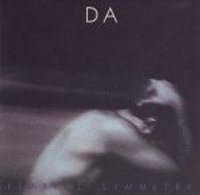When it comes to 80s music, there is NOTHING stranger than born again Christian new wave. Some artists in this genre were out-and-out hypocritical, writing albums with heavy gay bashing lyrics AND songs complaining of discrimination against born-againers. Steve Taylor was the worst of this lot, singing out of both sides of his mouth with “Whatever Happened To Sin?” (“I heard the reverend say/gay/is probably normal in the good Lord’s sight…I’m no morality nut/but/the reverend may be a little confused”) and “Meat The Press” (A Christian can’t get equal time/unless he’s a loony/committing a crime”). To be fair, I’m guessing (hoping?) Taylor wishes he could take back the worst of his 80s excesses…
On the opposite side of the fence is the band responsible for the album cover pictured here. Daniel Amos never indulged in the sort of nonsense some of their contemporaries did in attacking “non-believers”. Quite the opposite, Daniel Amos reserved their poison pens for members of their own movement. Here is a band that took aim at televangelists Jim and Tammy Bakker long before it became popular to do so on daytime television back in the late 80s.
The real genius of Daniel Amos–especially this album, Fearful Symmetry–is edgy electronic pop combined with a literacy startling when compared to some of their contemporaries. Where you had some Christian new wavers singing about going to hell forever (The 77s, an on-again/off-again new wave outfit, were exceptionally embarassing in that regard.) Daniel Amos chose to write songs invoking William Blake and wondering where the hell all the technological marvels of the space age got off to. Check the DA album Vox Humana for the insanely catchy “It’s the 80s, Where’s Our Rocket Packs?”
Fearful Symmetry is one of the best Daniel Amos albums of their long and bizarre career–this is a band which started out playing Eagles-style country-rock crossover music and suddenly flipped out into new wave. The band’s transition can be compared to when the Beatles started taking drugs…suddenly you had a whole new attitude informing the same group of songwriters previously satisfied with writing soppy three-minuters.
Vinyl sellers take note–I would pay LARGE DOLLARS to own the vinyl for this album. There are three simply perfect new wave tracks on Fearful Symmetry; “The Pool”, “Sleep, Silent Child” and “Shadow Catcher”. Oddly enough, this is the record founder genius Terry Taylor takes issue with, calling it “art rock”. But truly this is one powerhouse of a record with those three songs alone. “Neverland Ballroom” is amusing, “Instruction Through Film” is a Thomas Dolby-esque exercise, and I can completely do without “Sudden Heaven”. But this record is damn fine. You don’t need to be a born-againer to enjoy this and there’s no overt bible banging going on here. The religious imagery is appropriate where used and restrained enough to be **gasp** subtle. In an era where groups such as Ressurection Band and a gent named Rick Cua were hollering at people to “submit to Jesus” in so many words at maximum volume, Daniel Amos is the very picture of tolerant restraint, combined with great synth riffs, inspired arrangements (pun not intended) and ethereal imagery.

Fearful Symmetry is a favorite of mine as well, and I appreciate your thought and observations. I do have to take issue with your assessment of Steve Taylor. He wrote a lot of songs that were critical of lots of things, but in his defense, he was an equal-opportunity critic. He did call out homosexuality as morally offensive, but he was also very critical of many of his evangelical contemporaries (listen to Guilty by Association or This Disco Used to be a Cute Cathedral). Likewise he could be self-deprecating (listen to I Just Wanna Know, or Jesus is for Losers).
A lot of bands you mentioned such as the 77’s, Resurrection Band, and others were more thoughtful and complex than you are giving them credit for as well, but that is a discussion for another day.
I’d have to agree with Bill. The 77s, Steve Taylor, and Rez Band are hardly examples of the shallow, bumper-stickerism of the eighties. In fact, these were three of the brightest spots in the CCM landcape in terms of lyrical depth and quality.
Otherwise, good article . . . and it’s nice to hear that someone else appreciates “Sleep, Silent Child” as much as I do!